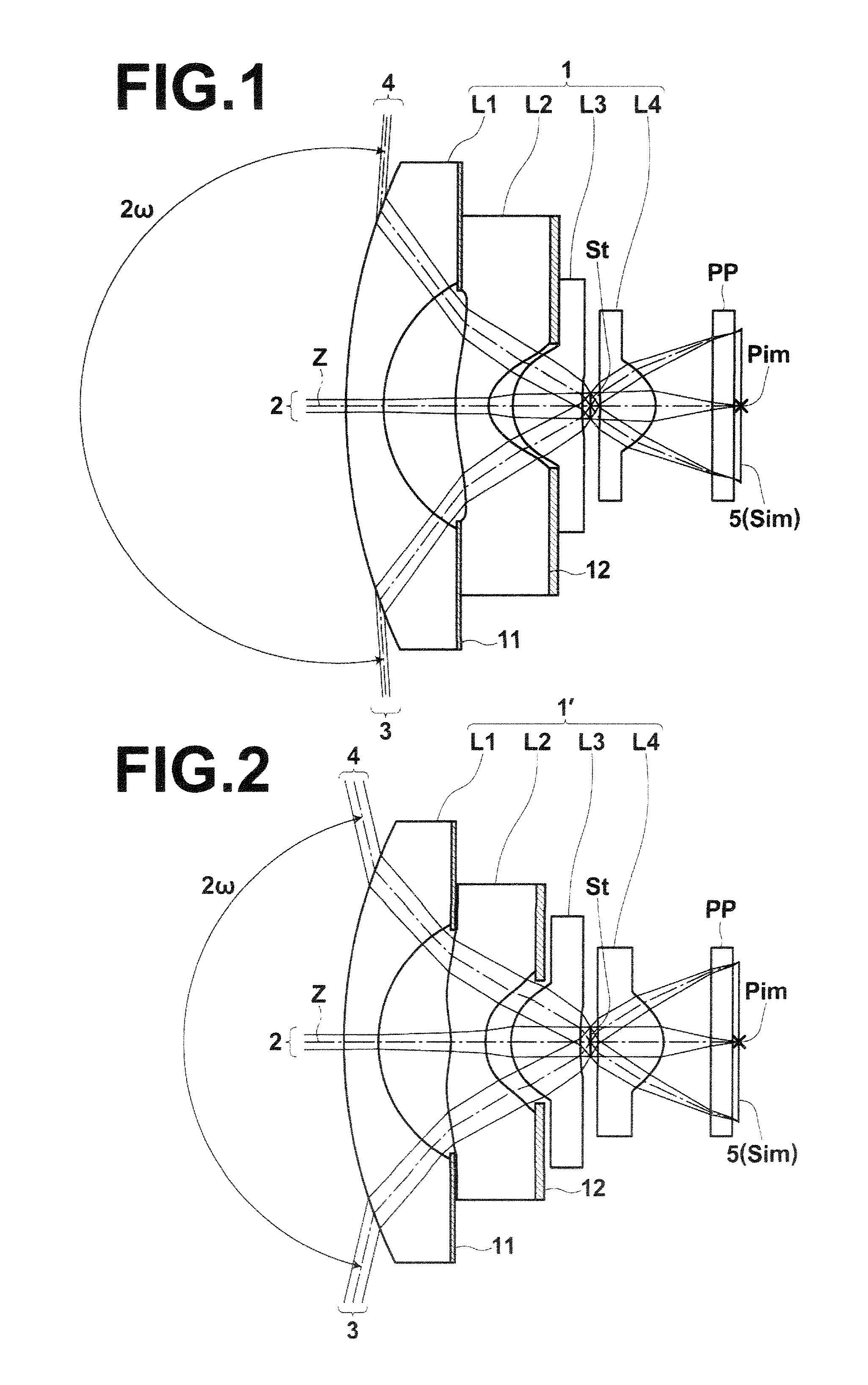Imaging lens and imaging apparatus
an imaging lens and imaging technology, applied in the field of imaging lenses and imaging apparatuses, can solve the problems of tougher requirements for imaging lenses mounted on in-vehicle cameras, surveillance cameras or the like, and achieve the effects of low cost, wide angle of view, and small siz
- Summary
- Abstract
- Description
- Claims
- Application Information
AI Technical Summary
Benefits of technology
Problems solved by technology
Method used
Image
Examples
first embodiment
[0139]Further, the imaging lens according to the present invention satisfies the following conditional formula (6):
0.75≦(R8−R9) / (R8+R9)≦1.0 (6), where
[0140]R8: a curvature radius of an object-side surface of fourth lens L4, and
[0141]R9: a curvature radius of an image-side surface of fourth lens L4.
[0142]When the upper limit and the lower limit of conditional formula (6) are satisfied, fourth lens L4 can have a plano-convex shape having a convex surface directed toward an image side or a meniscus shape having a convex surface directed toward the image side. Therefore, it is possible to excellently correct curvature of field and a spherical aberration. When the upper limit of conditional formula (6) is satisfied, the object-side surface of fourth lens L4 can be a flat surface or a concave surface. Therefore, it is possible to prevent the power of fourth lens L4 from becoming too strong, and to easily provide a long back focus. When the lower limit of conditional formula (6) is satisf...
second embodiment
[0147]Further, the imaging lens according to the present invention satisfies the following conditional formula (6-1):
0.60≦(R8−R9) / (R8+R9)≦1.0 (6-1).
[0148]When second lens L2 has a biconcave shape, it is possible to easily increase the power of second lens L2, and second lens L2 can sharply bend rays. Therefore, it is possible to reduce the angle of incidence of rays entering fourth lens L4. Therefore, even if the lower limit is 0.60, it is possible to suppress the angle of incidence of rays entering a sensor in a peripheral area. When the upper limit and the lower limit of conditional formula (6-1) are satisfied, fourth lens L4 can have a plano-convex shape having a convex surface directed toward an image side or a meniscus shape having a convex surface directed toward the image side. Therefore, it is possible to excellently correct curvature of field and a spherical aberration. When the upper limit of conditional formula (6-1) is satisfied, the object-side surface of fourth lens L...
third embodiment
[0152]Further, the imaging lens according to the present invention satisfies the following conditional formula (7):
6.2R8 / f| (7), where
[0153]R8: a curvature radius of an object-side surface of fourth lens L4, and
[0154]f: a focal length of an entire system.
[0155]When the lower limit of conditional formula (7) is satisfied, correction of a spherical aberration becomes easy.
[0156]Next, the structure of a fourth embodiment of the present invention will be described. An imaging lens according to the fourth embodiment of the present invention includes negative first lens L1, negative second lens L2 of a biconcave shape, third lens L3 of a plano-convex shape having a convex surface directed toward an object side or of a positive meniscus shape having a convex surface directed toward the object side, and fourth lens L4 of a plano-convex shape having a convex surface directed toward an image side or of a positive meniscus shape having a convex surface directed toward the image side, which ar...
PUM
 Login to View More
Login to View More Abstract
Description
Claims
Application Information
 Login to View More
Login to View More - R&D
- Intellectual Property
- Life Sciences
- Materials
- Tech Scout
- Unparalleled Data Quality
- Higher Quality Content
- 60% Fewer Hallucinations
Browse by: Latest US Patents, China's latest patents, Technical Efficacy Thesaurus, Application Domain, Technology Topic, Popular Technical Reports.
© 2025 PatSnap. All rights reserved.Legal|Privacy policy|Modern Slavery Act Transparency Statement|Sitemap|About US| Contact US: help@patsnap.com



